Deploying NetScaler
AppFirewall
Deployment Guide
This deployment guide provides general guidelines for deploying the
NetScaler Application Firewall.
Deployment Guidecitrix.com�
Table of Contents
Introduction
AppFirewall Features
Rules and Signatures
Integrating with other NetScaler features
Packet Processing with NetScaler and AppFirewall
Standard Workflow for Deploying AppFirewall
Deploying the AppFirewall
Basic and Advanced Policies
Custom Policy Bindings
Conclusion
3
3
7
8
8
9
11
12
16
18
2
Deployment Guidecitrix.comDeploying NetScaler AppFirewall�
Citrix NetScaler AppFirewall is a comprehensive ICSA certified web
application security solution that blocks known and unknown
attacks against web and web services applications. NetScaler
AppFirewall enforces a hybrid security model that permits only
correct application behaviour and efficiently scans and protects
against known application vulnerabilities. It analyzes all
bidirectional traffic, including SSL-encrypted communication, to
protect against a broad range of security threats without any
modification to applications.
Introduction
NetScaler AppFirewall (also referred to as AppFirewall, Web Application Firewall or WAF) technol-
ogy is included in and integrated with Citrix NetScaler MPX and NetScaler VPX , Platinum Edition,
and is available as an optional module that can be added to NetScaler MPX appliances running
NetScaler Enterprise Edition. NetScaler AppFirewall is also available as a stand-alone solution on
some NetScaler MPX appliances. The stand-alone NetScaler AppFirewall models can be upgraded
through software licensing to full NetScaler Application Delivery Controllers (ADCs).
This guide focuses on defining the general deployment guidelines for Citrix NetScaler AppFirewall.
The product versions described here are -
Product
NetScaler (AppFirewall Integrated
Module)
Version
10.5 (Enterprise/Platinum License)
AppFirewall Features
Hybrid security model
The NetScaler hybrid security model allows you to take advantage of both a positive security mod-
el and a negative security model to come up with a configuration ideally suited for your
applications.
The positive security model protects against Buffer Overflow, CGI-BIN Parameter Manipulation,
Form/Hidden Field Manipulation, Forceful Browsing, Cookie or Session Poisoning, Broken ACLs,
Cross-Site Scripting (XSS), Command Injection, SQL Injection, Error Triggering Sensitive Information
Leak, Insecure Use of Cryptography, Server Misconfiguration, Back Doors and Debug Options,
Rate-Based Policy Enforcement, Well Known Platform Vulnerabilities, Zero-Day Exploits, Cross Site
Request Forgery (CSRF), and leakage of Credit Card and other sensitive data.
The negative security model uses a rich set signatures to protect against L7 and HTTP application
vulnerabilities. The application firewall is integrated with several third party scanning tools, such as
those offered by Cenzic, Qualys, Whitehat, and IBM. The built-in XSLT files allow easy importation
3
Deployment Guidecitrix.comDeploying NetScaler AppFirewall�
of rules, which can be used in conjunction with the native-format Snort based rules. An auto-
update feature gets the latest updates for new vulnerabilities.
The positive security model might be the preferred choice for protecting applications that have a
high need for security, because it gives you the option to fully control who can access what data.
You allow only what you want and block the rest. This model includes a built-in security check
configuration, which is deployable with a few clicks. However, keep in mind that the tighter the
security, the greater the processing overhead.
The negative security model might be preferable for customized applications. The signatures allow
you to combine multiple conditions, and a match and the corresponding action are triggered only
when all the conditions are satisfied. You block only what you don’t want and allow the rest. A spe-
cific fast-match pattern in a specified location can significantly reduce processing overhead to
optimize performance. The option to add your own signature rules, based on the specific security
needs of your applications, gives you the flexibility to design your own customized security
solutions.
Request as well as response side detection and protection
You can inspect the incoming requests to detect any suspicious behavior and take appropriate
actions, and you can check the responses to detect and protect against leakage of sensitive data.
Rich set of built-in protections for HTML, XML and JSON payloads
The application firewall offers 19 different security checks. Six of them (such as Start URL and Deny
URL) apply to both HTML and XML data. Five checks (such as Field Consistency and Field Format)
are specific to HTML, and eight (such as XML Format and Web Service Interoperability) are specific
to XML payloads. This feature includes a rich set of actions and options. For example, URL Closure
enables you to control and optimize the navigation through your website, to safeguard against
forceful browsing without having to configure relaxation rules to allow each and every legitimate
URL. You have the option to remove or x-out the sensitive data, such as credit-card numbers, in the
response. Be it SOAP array attack protection, XML denial of service (XDoS), WSDL scan prevention,
attachment check, or any number of other XML attacks, you have the comfort of knowing that you
have an ironclad shield protecting your data when your applications are protected by the applica-
tion firewall. The signatures allow you to configure rules using XPATH-Expressions to detect
violations in the body as well as the header of a JSON payload.
GWT
Support for protecting Google Web Toolkit applications to safeguard against SQL, XSS and Form
Field Consistency check violations.
Java-free, user friendly graphical user interface (GUI)
An intuitive GUI and preconfigured security checks make it easy to deploy security by clicking a few
buttons. A wizard prompts and guides you to create the required elements, such as profiles, poli-
cies, signatures, and bindings. The HTML5 based GUI is free of any Java dependency. It’s
performance is significantly better than that of the older, Java based versions.
4
Deployment Guidecitrix.comDeploying NetScaler AppFirewall�
Easy to Use and automatable CLI
Most of the configuration options that are available in GUI are also available in the command line
interface (CLI). The CLI commands can be executed by a batch file and are easy to automate.
Support for REST API
The NetScaler NITRO protocol supports a rich set of REST API’s to automate application firewall
configuration and collect pertinent statistics for ongoing monitoring of security violations.
Learning
The application firewall’s ability to learn by monitoring traffic to fine tune security is very user
friendly. The learning engine recommends rules, which makes it easy to deploy relaxations without
proficiency in regular expressions.
RegEx editor support
Regular expression offer an elegant solution to the dilemma of wanting to consolidate rules and
yet optimize search. You can capitalize on the power of regular expressions to configure URLs,
field names, signature patterns, and so on. The rich built-in GUI RegEx editor offers you a quick ref-
erence for the expressions and provides a convenient way to validate and test your RegEx for
accuracy.
Customized error page
Blocked requests can be redirected to an error URL. You also have the option to display a custom-
ized error object that uses supported variables and Citrix default syntax (advanced PI expressions)
to embed troubleshooting information for the client.
PCI-DSS, stats, and other violation reports
The rich set of reports makes it easy to meet the PCI-DSS compliance requirement, gather stats
about traffic counters, and view violation reports for all profiles or just one profile.
Logging and click-to-rule from log
Detailed logging is supported for native as well as CEF format. The application firewall offers you
the ability to filter targeted log messages in the syslog viewer. You can select a log message and
deploy a corresponding relaxation rule by a simple click of a button. You have the flexibility to cus-
tomize log messages and also have support for generating web logs. For additional details, see
http://docs.citrix.com/en-us/netscaler/11/security/application-firewall/logs.html.
Include violation logs in trace records
The ability to include log messages in the trace records makes it very easy to debug unexpected
behavior such as reset and block.
Cloning
The useful Import/Export profile option allows you to clone the security configuration from one
NetScaler appliance to others. Export learned data options make it easy to export the learned rules
to an Excel file. You can then get them reviewed and approved by the application owner before
applying them.
5
Deployment Guidecitrix.comDeploying NetScaler AppFirewall�
AppExpert Templates
An AppExpert template (a set of configuration settings) can be designed to provide appropriate
protection for your websites. You can simplify and expedite the process of deploying similar pro-
tection on other appliances by exporting these cookie-cutter templates to a template file. For
additional details, see http://docs.citrix.com/en-us/netscaler/10-5/ns-appexpert-con-10/ns-
aapexpert-apptemp-wrapper-con.html
Sessionless security checks
Deploying sessionless security checks can help you reduce the memory footprint and expedite the
processing.
Interoperability with other NetScaler features
The application firewall works seamlessly with other NetScaler features, such as rewrite, URL trans-
formation, integrated caching, CVPN, and rate limiting.
Support of PI expressions in policies
You can leverage the power of advanced PI expressions to design policies to implement different
levels of security for different parts of your application.
Support for IPv6
The application firewall supports both IPv4 and IPv6 protocols.
Geolocation based security protection:
You have the flexibility of using Citrix default syntax (PI Expressions) for configuring location based
policies, which can be used in conjunction with a built-in location database to customize firewall
protection. You can identify the locations from which malicious requests originate, and enforce the
desired level of security-check inspections for requests that originate from a specific geographical
location.
Performance
Request-side streaming significantly improves performance. As soon as a field is processed, the
resulting data is forwarded to the back end while evaluation continues for the remaining fields.
The improvement in processing time is especially significant when handling large posts.
Other security features
The application firewall has several other security knobs that can help ensure the security of your
data. For example, the Confidential Field lets you block leakage of sensitive information in the log
messages, and Strip HTML Comment allows you to remove the HTML comments from the
response before forwarding it to the client. Field Types can be used to specify what inputs are
allowed in the forms submitted to your application.
6
Deployment Guidecitrix.comDeploying NetScaler AppFirewall�
Rules and Signatures
The application firewall makes it very easy to design the right level of security for your applications.
You can have multiple application firewall policies, bound to different application firewall profiles,
to implement different levels of security-check inspections for your applications. You can initially
monitor the logs to observe what security threats are being detected and which violations are
being triggered. Rule creation is made straightforward with the application firewall’s rule engine,
which supports two types of rules – learned rules and relaxation rules. You can either manually add
relaxation rules or take advantage of the application firewall’s recommended learned rules to
deploy the required relaxations to avoid false positives.
The Citrix application firewall offers visualizer support in the GUI, which makes rule management
very easy. You can easily view all the data on one screen, and take action on several rules with one
click. The biggest advantage of the visualizer is that it recommends regular expressions to consoli-
date several rules. You can select a subset of the rules, basing your selection on the delimiter and
Action URL. Visualizer support is available for viewing 1) learned rules and 2) relaxation rules.
1) The visualizer for learned rules offers the option to edit the rules and deploy them as relaxations.
You can also skip (ignore) rules.
2) The visualizer for deployed relaxations offers you the option to add a new rule or edit an existing
one. You can also enable or disable a group of rules by selecting a node and clicking the Enable or
Disable button in the relaxation visualizer.
A signature is an object that can have multiple rules. Each rule consists of one or more patterns
that can be associated with a specified set of actions. The application firewall has a built-in default
signature object consisting of more than 1,300 signature rules, with an option to get the latest
rules by using the auto-update feature to get protection against new vulnerabilities. Rules created
by other scan tools can also be imported.
Signatures are very powerful because they use pattern matching to detect malicious attacks and
can be configured to check both the request and the response of a transaction. They are a pre-
ferred option when a customizable security solution is needed. Multiple action choices (for
example, block, log, learn, and transform) are available for when a signature match is detected.
The default signatures, such as web-cgi, web-coldfusion, web-frontpage, web-iis, web-php, web-
client, web-activex, web-shell-shock, and web-struts, cover rules to protect different types of
applications. To match the needs of your application, you can select and deploy the rules belong-
ing to a specific category.
7
Deployment Guidecitrix.comDeploying NetScaler AppFirewall�
Signature usage tips:
• You can just make a copy of the default signature object and modify it to enable the rules you
need and configure the actions you want.
• The signature object can be customized by adding new rules, which can work in conjunction with
other signature rules.
• The signature rules can also be configured to work in conjunction with the security checks speci-
fied in the application firewall profile. If a match indicating a violation is detected by a signature
as well as a security check, the more restrictive action is the one that gets enforced.
• A signature rule can have multiple patterns and be configured to flag a violation only when all
the patterns are matched, thereby avoiding false positives.
• Careful selection of a literal fast-match pattern for a rule can significantly optimize processing
time.
Integrating with other NetScaler features
The application firewall is fully integrated into the NetScaler appliance and works seamlessly with
other features. You can configure maximum security for your application by using other NetScaler
security features in conjunction with the application firewall. For example, AAA-TM can be used to
authenticate the user, check the user’s authorization to access the content, and log the accesses,
including invalid login attempts. Rewrite can be used to modify the URL or to add, modify or delete
headers, and responder can be used to deliver customized content to different users. You can
define the maximum load for your website by using rate limiting to monitor the traffic and throttle
the rate if it is too high. HTTP Denial-of-Service (DoS) protection can help distinguish between real
HTTP clients and malicious DoS clients. You can narrow the scope of security-check inspection by
binding the application firewall policies to virtual servers, while still optimizing the user experience
by using the load balancing feature to manage heavily used applications. Requests for static
objects such as images or text can bypass security check inspection, taking advantage of integrat-
ed caching or compression to optimize the bandwidth usage for such content.
Packet Processing with NetScaler and AppFirewall
The flow of a packet in the NetScaler appliance is shown in the diagram below. This diagram is also
available in the Processing Order of Features section at http://docs.citrix.com/en-us/netscaler/11/
getting-started-with-netscaler.html.
8
Deployment Guidecitrix.comDeploying NetScaler AppFirewall�
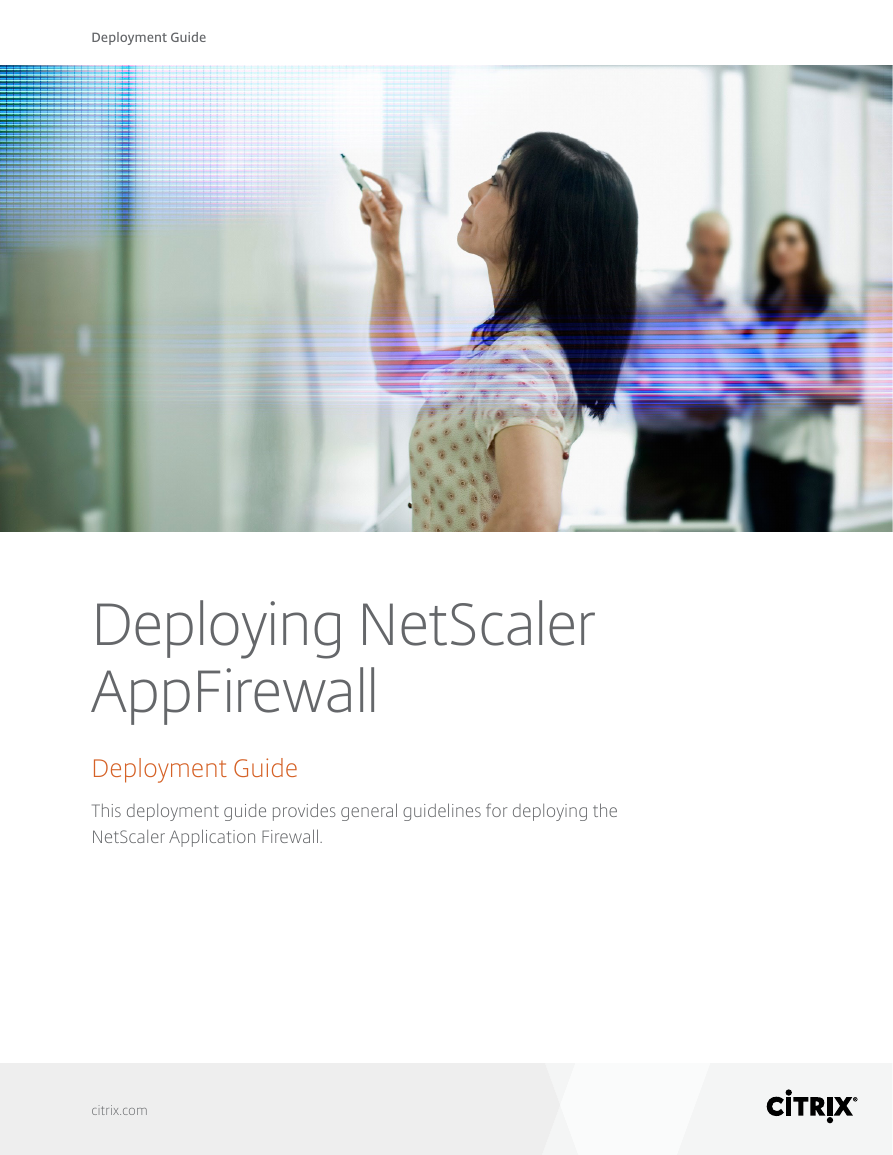

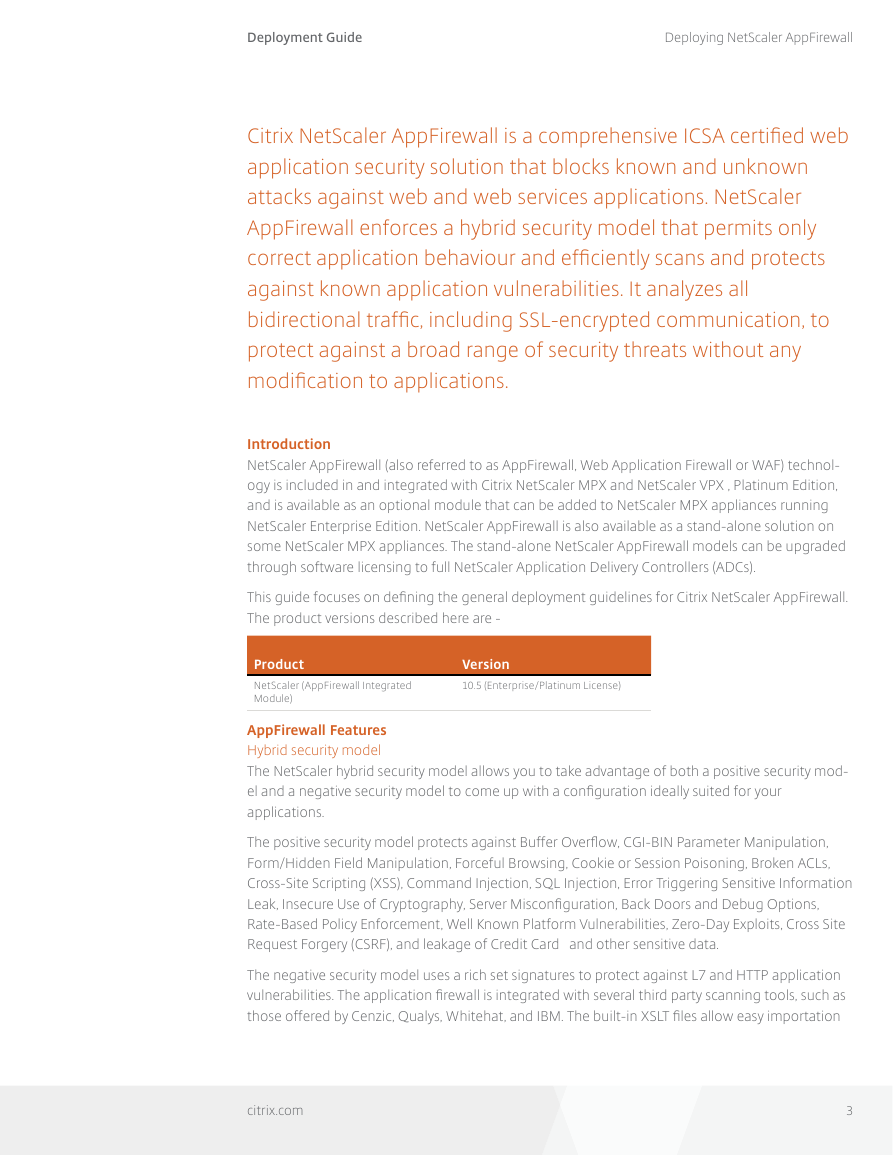
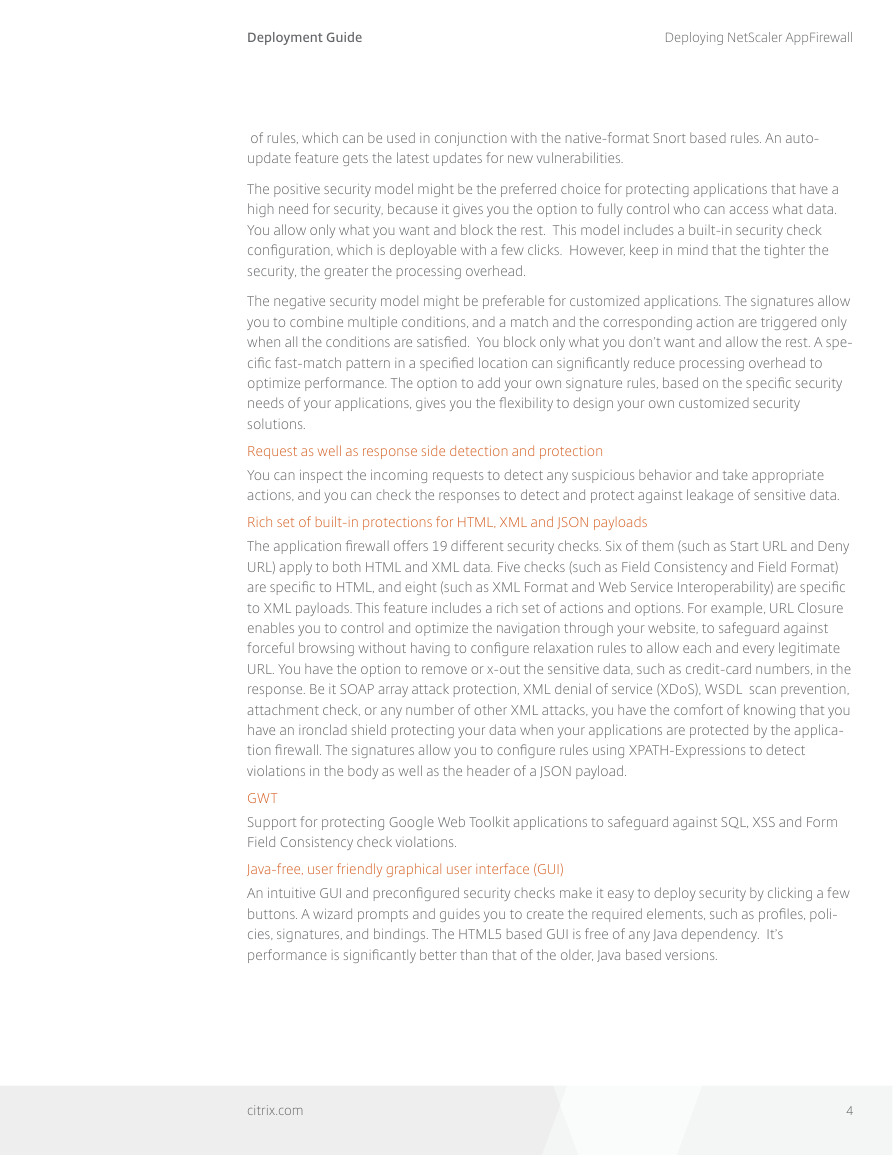
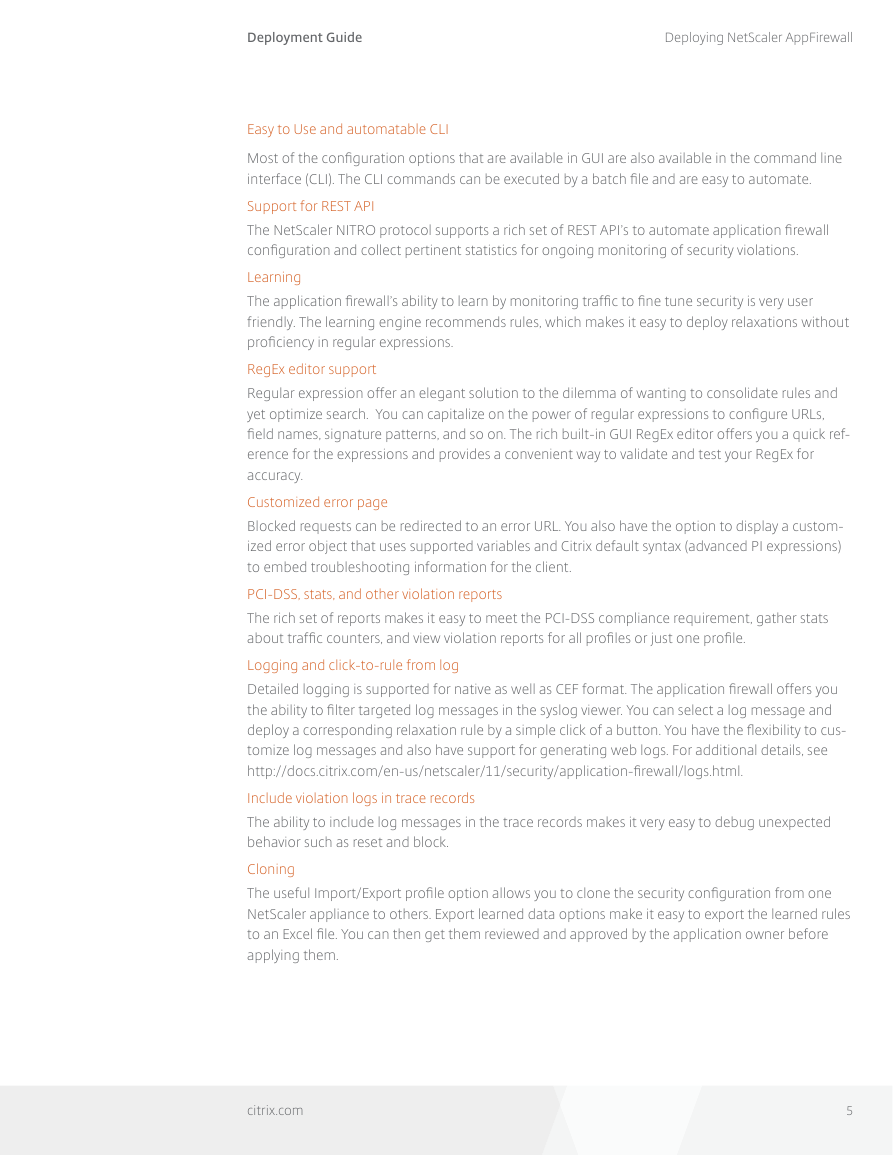
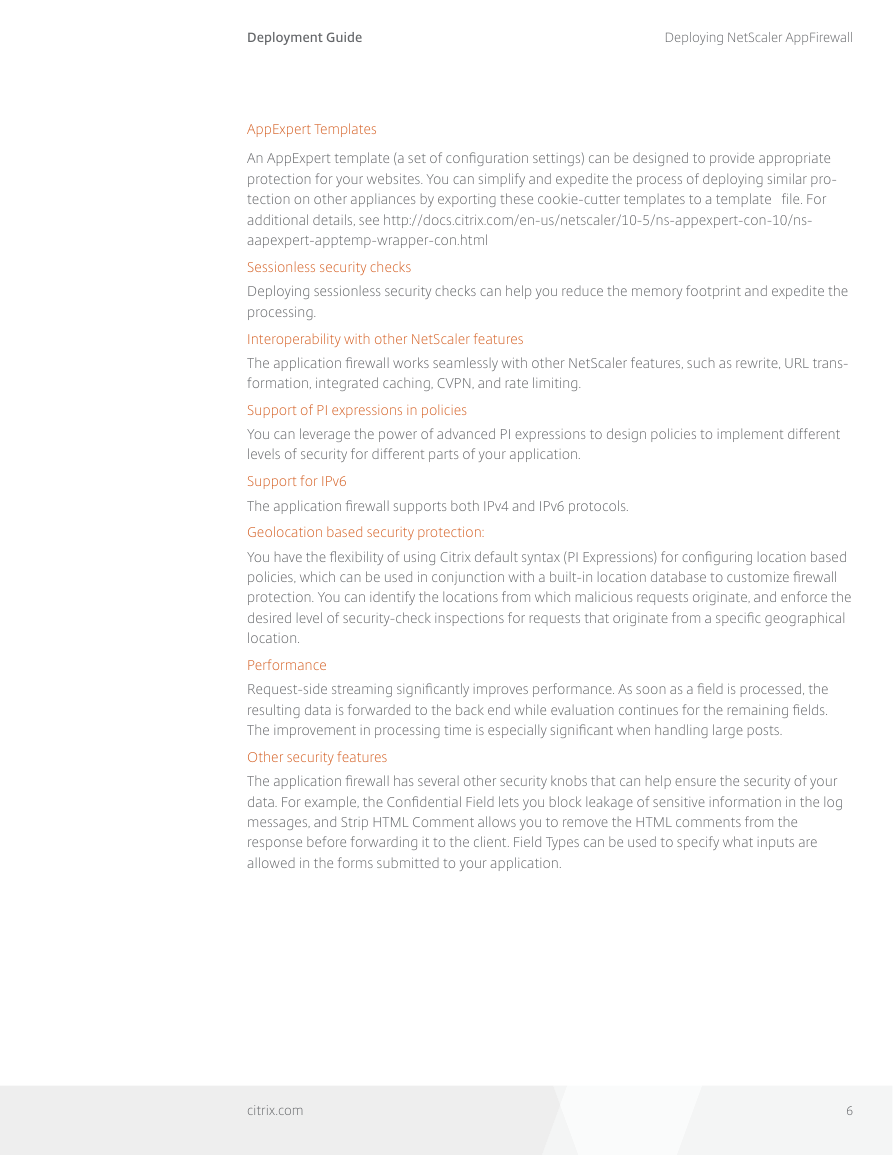
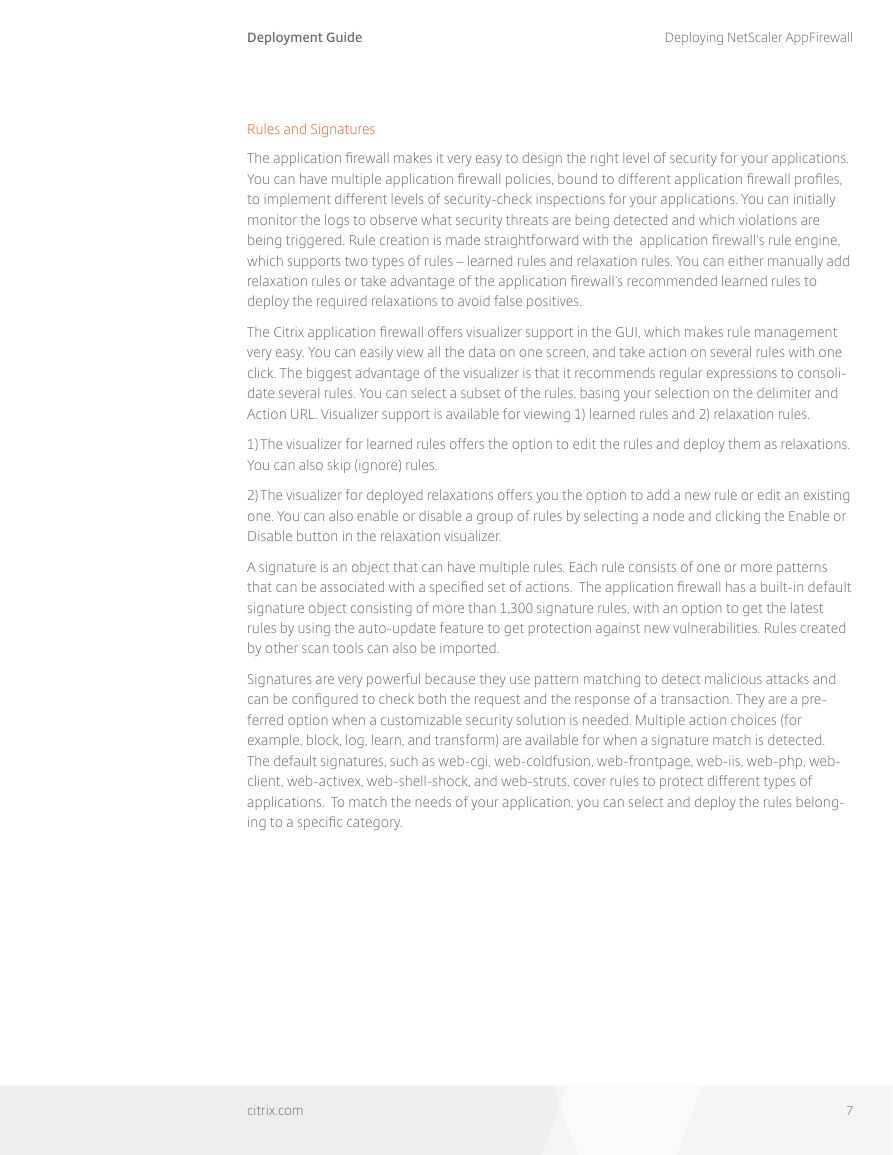
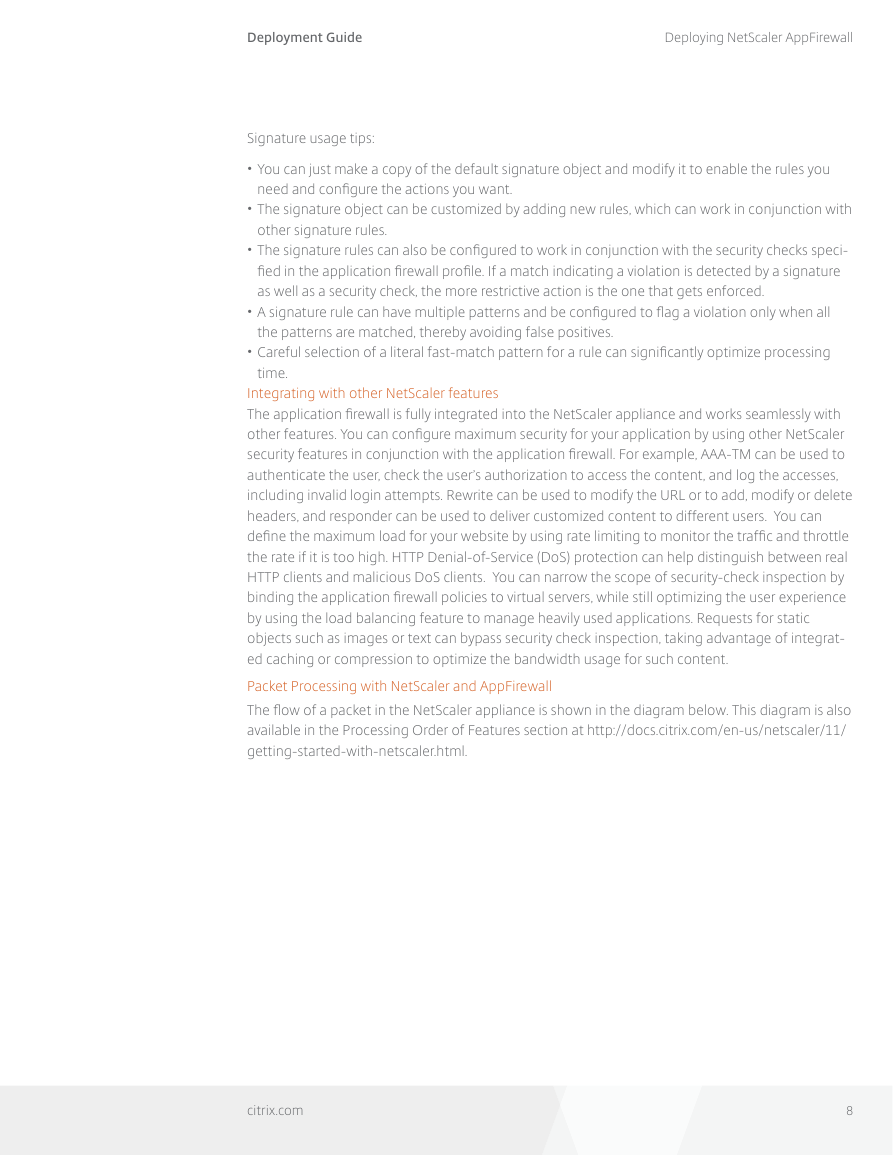








 2023年江西萍乡中考道德与法治真题及答案.doc
2023年江西萍乡中考道德与法治真题及答案.doc 2012年重庆南川中考生物真题及答案.doc
2012年重庆南川中考生物真题及答案.doc 2013年江西师范大学地理学综合及文艺理论基础考研真题.doc
2013年江西师范大学地理学综合及文艺理论基础考研真题.doc 2020年四川甘孜小升初语文真题及答案I卷.doc
2020年四川甘孜小升初语文真题及答案I卷.doc 2020年注册岩土工程师专业基础考试真题及答案.doc
2020年注册岩土工程师专业基础考试真题及答案.doc 2023-2024学年福建省厦门市九年级上学期数学月考试题及答案.doc
2023-2024学年福建省厦门市九年级上学期数学月考试题及答案.doc 2021-2022学年辽宁省沈阳市大东区九年级上学期语文期末试题及答案.doc
2021-2022学年辽宁省沈阳市大东区九年级上学期语文期末试题及答案.doc 2022-2023学年北京东城区初三第一学期物理期末试卷及答案.doc
2022-2023学年北京东城区初三第一学期物理期末试卷及答案.doc 2018上半年江西教师资格初中地理学科知识与教学能力真题及答案.doc
2018上半年江西教师资格初中地理学科知识与教学能力真题及答案.doc 2012年河北国家公务员申论考试真题及答案-省级.doc
2012年河北国家公务员申论考试真题及答案-省级.doc 2020-2021学年江苏省扬州市江都区邵樊片九年级上学期数学第一次质量检测试题及答案.doc
2020-2021学年江苏省扬州市江都区邵樊片九年级上学期数学第一次质量检测试题及答案.doc 2022下半年黑龙江教师资格证中学综合素质真题及答案.doc
2022下半年黑龙江教师资格证中学综合素质真题及答案.doc